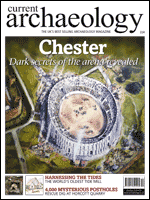 This month’s CA covers a lot of ground, with up-to-the minute results from this season’s excavations at both Chester Amphitheatre and Horcott Quarry. We take the plunge into the frigid waters of Northern Ireland for a closer look at the economy of a medieval monastery, and examine the 11th century English countryside as revealed by the recently completed set of maps based on the Domesday book. Editor in Chief Andrew Selkirk adds to the topical mix with a review of London Mayor Boris Johnson’s recent book, The Dream of Rome, which is an interesting mix of old and new, discussing current political theories and putting Rome in a modern context. We’ve been thinking about UNESCO’s recent criticisms of Britain’s ‘lack of clarity’ in managing the conflicts between conservation and development; we would love to hear from our readers on this topic. Is it being blown out of proportion, or is UNESCO correct in their accusation?
This month’s CA covers a lot of ground, with up-to-the minute results from this season’s excavations at both Chester Amphitheatre and Horcott Quarry. We take the plunge into the frigid waters of Northern Ireland for a closer look at the economy of a medieval monastery, and examine the 11th century English countryside as revealed by the recently completed set of maps based on the Domesday book. Editor in Chief Andrew Selkirk adds to the topical mix with a review of London Mayor Boris Johnson’s recent book, The Dream of Rome, which is an interesting mix of old and new, discussing current political theories and putting Rome in a modern context. We’ve been thinking about UNESCO’s recent criticisms of Britain’s ‘lack of clarity’ in managing the conflicts between conservation and development; we would love to hear from our readers on this topic. Is it being blown out of proportion, or is UNESCO correct in their accusation?
DARK SECRETS OF THE ARENA REVEALED
Major new excavations at Chester have re-examined earlier projects and refined our understanding of Roman Britain’s largest amphitheatre. Additionally, new excavations in fresh ground, where the Roman remains were undisturbed, have turned up Britain’s first evidence for the stalls and vendors that were all part of a day out at the games. We report on how the dig has challenged previous interpretations as well as shed new light on how central the bloody games were to Romano-British life.
HARNESSING THE TIDES
Close to the ruins of the Medieval monastery of Nendrum on Strangford Lough in Northern Ireland, the chance discovery of a tiny fragment of granite millstone and a sherd of late 7th century pottery has led archaeologists to the world’s oldest known excavated tide mill. But for those eleventh-hour discoveries, the chance to gain new insights into the economy of an early medieval monastery would have been lost. We have the fascinating details.
HORCOTT QUARRY
Oxford Archaeology’s experts had the unenviable task of disentangling a mysterious, multi-period hotchpotch of over 4,000 postholes at Horcott Quarry. Racing against the clock ahead of gravel extraction, joining the dots has revealed more than 1,000 years of consecutive settlement – from the Early Iron Age, through the Romano-British era to the Early and Middle Saxon periods. Moreover, according to the archaeologists, this complex rescue site has shown its occupants ‘clearly had pretensions of grandeur’!
MAPPING DOMESDAY
William the Conqueror commissioned a massive tome to inventory the spoils of war gained by his success at Hastings. The Domesday Book contains a survey so comprehensive that it continues to be a rich source of information for historians and archaeologists 900 years later. However, there were never any maps — until now. We take a closer look at this 11th century version of Google Earth.
LAST WORD
Mayor Boris on Rome
ODD SOCS
The Round Tower Churches Society



